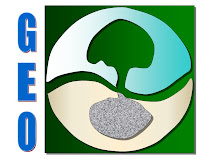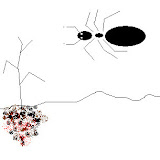Saturday, August 30, 2014
Thursday, April 30, 2009
Wednesday, August 20, 2008
Terra Preta Experiment _ 3
Six, bean seeds were planted in the control pot with red soil and pot with mix of Red soil and charcoal (30% charcoal by volume as compared to the red soil used). The 3 beans have germinated in control pot and 6 beans have germinated in pot with mix of red soil and charcoal. Other results are visible in the photographs presented above.
Wednesday, April 23, 2008
TP URINE EXPERIMENT PHOTOS
Beans 10 day old saplings
Left Side: Charcoal+Urine+red soil 0-|-0 Right Side: Charcoal+red soil
Dark Green Leaves 0-|-0 Light Green Leaves
The volume of charcoal and red soils is same in both the pots i.e., 50% Charcoal and 50% Red soil in volume.
The urine has contributed the nitrogen for the saplings, that is the reason why the leaves of left side sapling are dark green in color.
The clay pots which were filled with charcoal for collecting urine, by keeping them in the toilet used by kids.
TERRA PRETA & URINE
I prefer and agree to collect the urine fresh from the source using
charcoal without loosing any value. Here is what I am doing.
I requested my kids to urinate in the clay jars (~ 6 inches diameter
and ~10 inches height) with very fine holes (2mm dia) at the
bottom filled with charcoal produced from using Magh-1 woodgas stoves.
These jars are kept in the toilet are able to absorb about 200 ml of
urine (single time) easily with out any leakage at the bottom. Between
the intervals of urination of about 6 hours duration, the moisture is
reduced to some extent, but always wet and cool because of clay
jars. The total urine per day was around 500 ml. After about 10 days I
could smell something like ammonia from the jar, I thought now it has
reached saturation level. I kept the jar aside in a cool place to use
for experiments. I have not analysed for actual contents in this product.
The advantages / ideas are:
The coolness of the clay jar reduced evaporation losses
Reduction of urine odor as charcoal is used, more acceptance to
collect urine fresh in the toilets, we can easily design urinals free
of smell, instead of using fresheners (napthaline balls, scents,
phenyl, etc) in the toilets.
The schools are the best places to get kids urine, disease free and no
medicines used.
No flies are seen sitting on the jars, but some big black ants seen to
enjoy drinking the urine spilled ? ?
And many other advantages as discussed earlier in the group.
charcoal without loosing any value. Here is what I am doing.
I requested my kids to urinate in the clay jars (~ 6 inches diameter
and ~10 inches height) with very fine holes (2mm dia) at the
bottom filled with charcoal produced from using Magh-1 woodgas stoves.
These jars are kept in the toilet are able to absorb about 200 ml of
urine (single time) easily with out any leakage at the bottom. Between
the intervals of urination of about 6 hours duration, the moisture is
reduced to some extent, but always wet and cool because of clay
jars. The total urine per day was around 500 ml. After about 10 days I
could smell something like ammonia from the jar, I thought now it has
reached saturation level. I kept the jar aside in a cool place to use
for experiments. I have not analysed for actual contents in this product.
The advantages / ideas are:
The coolness of the clay jar reduced evaporation losses
Reduction of urine odor as charcoal is used, more acceptance to
collect urine fresh in the toilets, we can easily design urinals free
of smell, instead of using fresheners (napthaline balls, scents,
phenyl, etc) in the toilets.
The schools are the best places to get kids urine, disease free and no
medicines used.
No flies are seen sitting on the jars, but some big black ants seen to
enjoy drinking the urine spilled ? ?
And many other advantages as discussed earlier in the group.
Saturday, January 19, 2008
GERMINATION AND NITROGEN
It is observed that the chances of seeds germination is found to be 20 to 30 percent in the soils with charcoal as compared to control soil (red soil).

CONTROL RED SOIL-------- RED SOIL WITH CHARCOAL
Probably we need to add more nitrogen to the soil with charcoal, as may be some part of the nitrogen is absorbed by the charcoal and some part might have been used up by the living microbes. Of course there is a chance that the remaining nitrogen is released by the charcoal slowly into the soil for the plants to absorb.
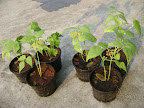
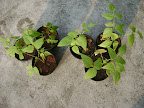
CONTROL POTS WITH RED SOIL-------- POTS WITH RED SOIL & CHARCOAL
Note: The above comments are based on physical observations, in an open environment. No pesticide / fertilizer is applied to the soil organic or inorganic.
Probably we need to add more nitrogen to the soil with charcoal, as may be some part of the nitrogen is absorbed by the charcoal and some part might have been used up by the living microbes. Of course there is a chance that the remaining nitrogen is released by the charcoal slowly into the soil for the plants to absorb.
CONTROL POTS WITH RED SOIL-------- POTS WITH RED SOIL & CHARCOAL
Note: The above comments are based on physical observations, in an open environment. No pesticide / fertilizer is applied to the soil organic or inorganic.
Sunday, December 23, 2007
GROWTH OF BEANS IN TERRA PRETA
After sowing beans and when observed after one week, it is seen that 9 sprouts have emerged from TP pots and only 8 sprouts emerged from control soil(10 nos of bean seeds were used covering 5 TP and 5 control pots, with 2 bean seeds in each pot). The plants are taller and are healthy in the Terra Preta pots as compared to the control pots. The watering to the pots was erratic, i.e., not a particular timing was followed and two days they were left with out water.
TERRA PRETA AND ANTS
One or two red ants were seen today in the TP pots, they have not burrowed the soil, they were found trespassing the pots. It means that ants are more repellant to the freshly added charcoal and over a period of time the charcoal impact on ants becomes mild. This is good, because we can repel ants with fresh charcoal when needed as we dont want to completely expel ants and other beneficial insects from our fields.
TERRA PRETA AND ANTS
One or two red ants were seen today in the TP pots, they have not burrowed the soil, they were found trespassing the pots. It means that ants are more repellant to the freshly added charcoal and over a period of time the charcoal impact on ants becomes mild. This is good, because we can repel ants with fresh charcoal when needed as we dont want to completely expel ants and other beneficial insects from our fields.
Sunday, December 16, 2007
Terra Preta NUGGETS
In this experiment, I have mixed redsoil (~40%), Charcoal (~50%) and little ash (~10%)in water, created small nuggets and dried them in the sunlight for about 3 hours (20 to 30 deg centigrade temperature), there was also a mild breeze of air too.
These nuggets were put in Magh-1 stove]] along with Maize cobs which were used as fuel and then lit. For keeping them in the Magh -1 stove for about 10 minutes, just enough maize cobs were added. While the stove was burning, I could also heat some water. The end result was hard TP Nuggets - With a combination of charcoal, little ash and burnt red soil. This is a hybrid product having characteristics of pottery shreds and charcoal which exists in TP.
Probable applications and uses:
- Such TP nuggets produced in large numbers could be used in Horticulture where we concentrate more on each plant rather than the spread.
- In small scale could be used for flower pots at home, for the people who many not be able to take care of the pots every day - expecially watering the pots.
- These TP nuggets could be used in the compost pits - vermicompost, farm yard manure, etc.
- They could be used for introducing microbes as they were used in the Alkaline Soil treatment process using charcoal.
- They many not repel some good insects like Wasps, Bees, Ants, etc.
- Very clean to store, durable and easy to transport
- There could be some more applications like as a filtering media, for water purification, in aquarium water filters and as gravel in aquariums, etc.
- These nuggets are relatively heavy, otherwise some part the charcoal added into the soil would have been washed away or moved with passing time from the respective fields with rain and wind. These nuggets with charcoal and burnt earth (comparable to pottery shards) called TP nuggets would tend to remain longer time in the soil.
- There could be some more applications which, I am unable to imagine presently. Requesting for your suggestions and in further improvement of the process of Production of TP Nuggets.
Positive aspect is that the Magh-1 stove which is highly efficient and the end product was charcoal a by product.
Note: This experiment is a low cost research work (roof top and Kitchen lab), regarding the quality of TP Nuggets, its porosity, temperature at which they were produced etc., there is a need to do systematic research.
TP and water
In this experiment, I have used two pots one with red soil and another with red soil and charcoal (from Magh-1 woodgas stove). This experiment was to see the rate of seepage of water and its quality. These two pots were prepared about 5 days back and were being watered every day twice. Although I am watering them everyday today I wanted to see their seepage properties. Note these two pots have holes at the bottom.
The experiment is simple, took two clean ceramic plates and placed these two pots. Added equal amount of water in both the pots simultaneously. Two observations I noticed:
1. The water retention is more in the pot with charcoal and the seepage is slow.
2. The pot without charcoal released turbid water and the water from charcoal pot was clear and clean.
This a good exercise which could be taught to children to tell about the uses of TP.
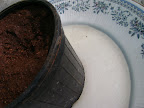

Quality of water could be observed in the above two photographs
The experiment is simple, took two clean ceramic plates and placed these two pots. Added equal amount of water in both the pots simultaneously. Two observations I noticed:
1. The water retention is more in the pot with charcoal and the seepage is slow.
2. The pot without charcoal released turbid water and the water from charcoal pot was clear and clean.
This a good exercise which could be taught to children to tell about the uses of TP.
Quality of water could be observed in the above two photographs
Wednesday, December 12, 2007
Today I saw that all the pots without charcoal are with small red ants. There is not a single ant in the pot with charcoal addition.
Although I love ants, to avoid ants eating away the seeds sown, we could always add some charcoal along with the seeds. Second important application is that in the Vermicompost pits some ants eat away the earthworms to avoid such problem and for value addition to the compost to create a habitat for microbes, we could as well add charcoal.
Although I love ants, to avoid ants eating away the seeds sown, we could always add some charcoal along with the seeds. Second important application is that in the Vermicompost pits some ants eat away the earthworms to avoid such problem and for value addition to the compost to create a habitat for microbes, we could as well add charcoal.
Tuesday, December 11, 2007
Terra Preta and Ants
Today is the first day after establishing pots and sown the seed (brinjal) to compare the soil with and without charcoal. I have sowed brinjal seeds in the 12 pots (6+6). To my surprise I saw that in the three control pots the seeds were eaten away by small red ants. The six pots with a mix of 30% charcoal and 70% red soil produced from use of Magh-1 stoves are untouched by ants. TP also acts as a repellent for ants, the chances for the germination of seeds with out any loss to creatures like ants is minimized. I thought this is the first direct benefit apart from Carbon sequestration in TP practice.
ANTS
Ants dominate most ecosystems, and form 15–20% of the terrestrial animal biomass.[3]
Ants perform many ecological roles that are beneficial to humans, including the suppression of pest populations and aeration of the soil. The use of weaver ants in citrus cultivation in southern China is considered one of the oldest known applications of biological control.[6] On the other hand, ants can become nuisances when they invade buildings, or cause economic losses.
Some species are valued in their role as biological pest control agents.[6] However, their ability to exploit resources brings ants into conflict with humans, as they can damage crops and invade buildings. Some species, such as the red imported fire ant, are regarded as invasive species, since they can spread rapidly into new areas.[7]
ANTS
Ants dominate most ecosystems, and form 15–20% of the terrestrial animal biomass.[3]
Ants perform many ecological roles that are beneficial to humans, including the suppression of pest populations and aeration of the soil. The use of weaver ants in citrus cultivation in southern China is considered one of the oldest known applications of biological control.[6] On the other hand, ants can become nuisances when they invade buildings, or cause economic losses.
Some species are valued in their role as biological pest control agents.[6] However, their ability to exploit resources brings ants into conflict with humans, as they can damage crops and invade buildings. Some species, such as the red imported fire ant, are regarded as invasive species, since they can spread rapidly into new areas.[7]
Subscribe to:
Posts (Atom)





